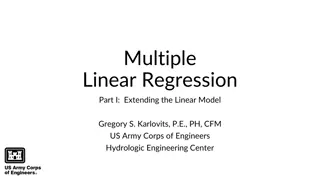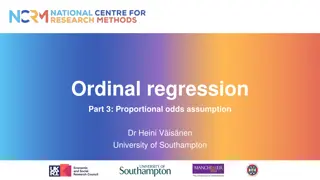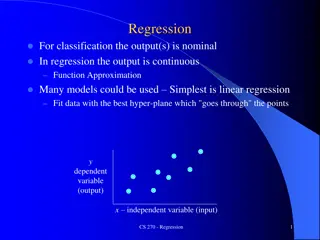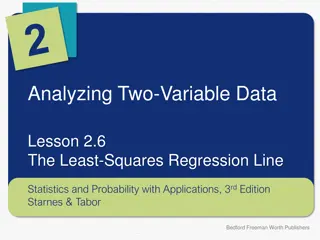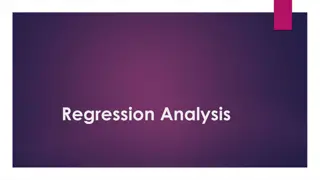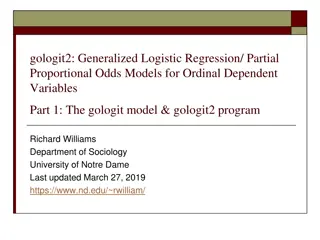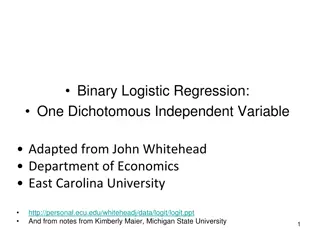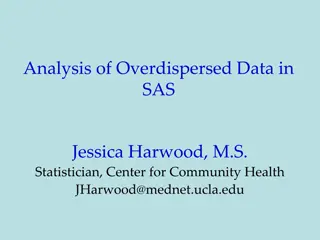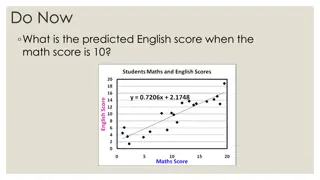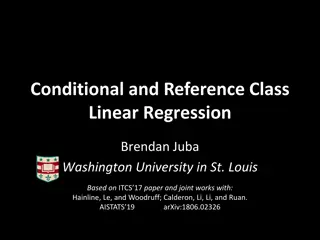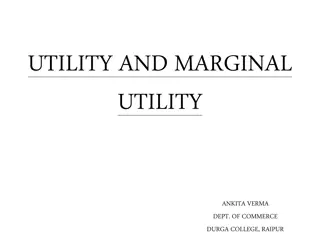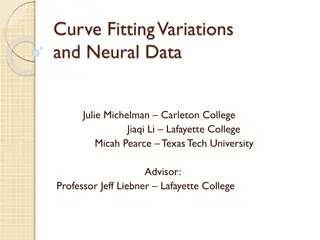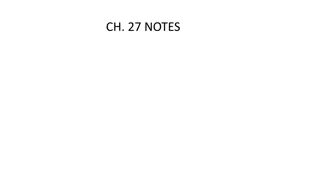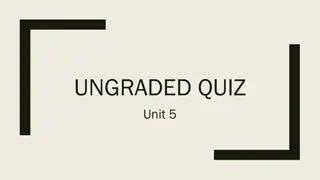Understanding Ordinal Regression in Data Analysis
Introduction to ordinal regression, a powerful tool for analyzing categorical variables with natural ordering. Explore cumulative odds, probabilities, and the proportional odds model. Learn about estimating equations, intercepts, and slopes in ordinal regression models. Discover how higher values of x correlate with increased odds of high response categories.
- Ordinal regression
- Data analysis
- Categorical variables
- Proportional odds model
- Cumulative probabilities
Download Presentation

Please find below an Image/Link to download the presentation.
The content on the website is provided AS IS for your information and personal use only. It may not be sold, licensed, or shared on other websites without obtaining consent from the author. Download presentation by click this link. If you encounter any issues during the download, it is possible that the publisher has removed the file from their server.
E N D
Presentation Transcript
Ordinal regression Part 1: Introduction Dr Heini V is nen University of Southampton
Outline Ordinal response variables Cumulative odds and probabilities Ordinal regression a.k.a. proportional odds model a.k.a. cumulative logit model
Ordinal response variables Many categorical variables have a natural ordering. Examples are: Severity of symptoms (low, medium and high). Attitude to a social question (in favour, indifferent, against). By using ordinal information a more informative and powerful analysis may be possible.
Cumulative probabilities - notation Pk Cpk 1-Cpk Probability of being in category k Cumulative probability of being in category k or lower Probability of being above category k Notes: 1) Cpk= p1+ p2+ . . . + pk 2) p1=Cp1, pk=Cpk Cpk-1(k=2, . . ., K-1), and pK= 1-CpK-1
Cumulative probabilities - example Suppose we have K=3 ordinal categories, with: p1= 0.5, p2= 0.3 and p3= 0.2 Then what is Cpkfor k = 1,2,3? Cp1= Pr(y 1) = p1 = 0.5 Cp2= Pr(y 2) = p1 + p2 = 0.5+0.3 = 0.8 Cp3= Pr(y 3) = 1, (the probability of being in the largest group or lower must be 100%)
Cumulative odds and log-odds Odds of being in at least category k to above category k ??? 1 ??? Log odds (cumulative logit) ??? ??? 1 ???
Ordinal regression model ??? 1 ??? ??? = ?? ?1?,? ??? ? = 1, ,? 1 We are estimating K-1 equations simultaneously. Each equation has ? different intercept ??(threshold) but a common slope ?. The intercepts are always ordered in size [?1< ?2< <?? 1]
Ordinal regression model ??? 1 ??? ??? = ?? ?1?,? ??? ? = 1, ,? 1 Positive b implies that higher values of x are associated with an increased odds of being in a high response category rather than a low response category. The same odds ratio applies to all thresholds because of the proportional odds assumption (i.e. the same slope holds for each equation).
Example: postgraduate school applications Undergraduate students reported how likely they were to apply for postgraduate study: Unlikely , Somewhat likely or Very likely . Is parents educational status (at least one graduate vs. none) associated with likelihood of applying? Postgraduate application Unlikely Somewhat likely Very likely Total N % 220 140 40 400 55.0 35.0 10.0 100.0 Data source: https://stats.idre.ucla.edu/stata/dae/ordered-logistic-regression/
Example: results (Stata) For students with educated parents, the odds of very likely versus the combined somewhat and unlikely categories are exp(1.127)=3.09 greater. Likewise, the odds of being in the combined very and somewhat likely categories versus unlikely are 3.09 times greater for those with educated parents. That is, the odds for being in a higher rather than a lower category of the outcome are higher for students with educated parents.
Calculation of probabilities (model with explanatory variables) exp(?? ??) 1 + exp(?? ??) ???= Parents not educated (PARED=0): exp(0.377 1.127 0) 1 + exp(0.377 1.127 0)= 0.59 ??1= ?1= exp(2.452 1.127 0) 1+exp(2.452 1.127 0)=0.92 ??2=
Calculation of probabilities (model with explanatory variables) exp(?? ??) 1 + exp(?? ??) ???= Parents not educated (PARED=0): ?2= ??2 ??1= 0.92 0.59 = 0.33 ?3= 1 ??2= 1 0.92 = 0.08
Table of response probabilities Likelihood to apply for PG Parents not educated Unlikely Somewha Very likely t likely 0.59 0.33 0.08 Parents educated 0.32 0.43 0.25
Thank you! Aknowledgements: the postgraduate school application slides developed originally by David Dawber.


